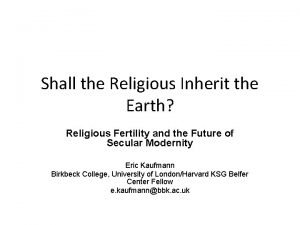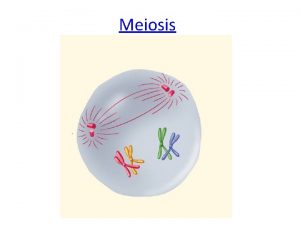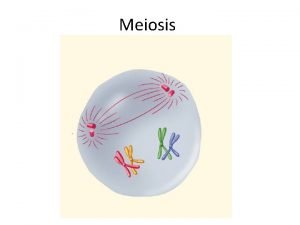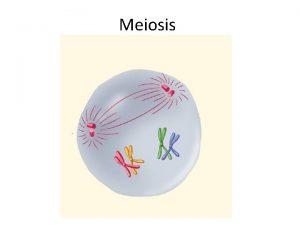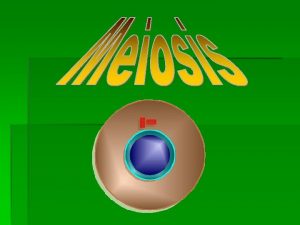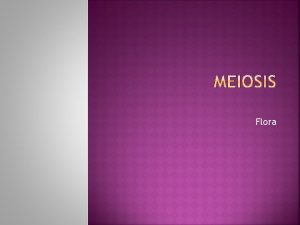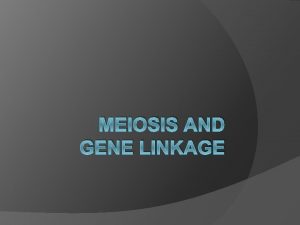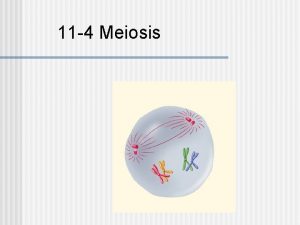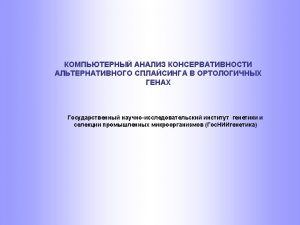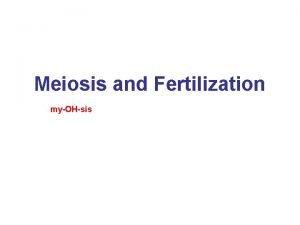Meiosis Each organism must inherit a single copy













- Slides: 13

Meiosis • Each organism must inherit a single copy of every gene from both its “parents”. One from the female and one from the male. • When an organism produces gametes, those two sets of genes must be separated form each other so that each gamete contains just one set of genes. • The process that separates the two sets of genes is called Meiosis.

Chromosome Number • Homologous Chromosomes ≡ the chromosomes that came from the male parent and its corresponding chromosome from the female parent.

Homologous Chromosomes

Chromosome Number • Diploid ≡ A cell that contains both sets of homologous chromosomes. – The number of chromosomes in a diploid cell is sometimes represented by the symbol 2 N. • Haploid ≡ Gametes of sexually reproducing organisms contain only a single set of chromosomes. – The number of chromosomes in a haploid cell is sometimes represented by the symbol N.


Phases of Meiosis • Meiosis ≡ a process of reduction division in which the number of chromosomes per cell is cut in half through the separation of homologous chromosomes in a diploid cell. • Meiosis has 2 phases: – Meiosis 1 – Meiosis 2

Meiosis 1 • Prior to meiosis I, each chromosome is replicated. • The cells begin to divide in a way that looks similar to mitosis. • Tetrad ≡ this structure forms when each chromosome pairs with its corresponding homologous chromosome

Meiosis 1 • Crossing Over ≡ when while they are in tetrads, they exchange portions of their chromatids. – Crossing Over results in the exchange of alleles between homologous chromosomes and produces new combinations of alleles.

n The homologous chromosomes separate, and two new cells are formed. n The two cells produced by meiosis 1 have sets of chromosomes and alleles that are different from each other and from the diploid cell that entered meiosis 1 Meiosis 1

Meiosis 2 • The two cells produced by meiosis 1 now enter a second meiotic division. • But unlike meiosis 1 – here in meiosis 2 there isn’t any chromosome replication – only division. • The four daughter cells produced in meiosis 2 now contain the haploid number of chromosomes.



Mitosis vs. Meiosis MITOSIS MEIOSIS Occurs in somatic cells. Occurs in reproductive cells. Consists of only one nuclear division. Consists of two nuclear divisions M-I and M-II. Cytokinesis takes place only once. May take place only once (simultaneous type) or twice (successive type). Involves division of chromosomes. Involves separation of homologous chromosomes in M-I and division of chromosomes in M-II. Dividing cells can be haploid or diploid. Dividing cells are diploid. Does not involve either pairing of homologous chromosomes or crossing over. Pairing of homologous chromosomes and crossing over occur during Prophase-I. Two daughter cells are formed. Four daughter cells are formed. Number of chromosomes present in the mother cell is maintained in both the daughter cells. Therefore it is an equational division. Diploid number of chromosomes is reduced to haploid in each daughter cell. Therefore it is a reduction division. Original characters of the chromosomes are maintained in the daughter cells. Chromosomal characters are altered due to "crossing over" causing recombination of genes. Daughter cells are similar to each other and also to the original mother cell. Daughter cells differ from each other as well as from the original mother cell. Helps in growth and body repairs. Helps in the sexual reproduction and regulation of chromosome number in the life cycle of sexually reproducing organism.
 Food chain
Food chain Ccr prodigal son
Ccr prodigal son The weak shall inherit the gym answers
The weak shall inherit the gym answers Shall the religious inherit the earth
Shall the religious inherit the earth He who overcomes
He who overcomes Inherited traits of a lion
Inherited traits of a lion Blessed are the meek for they shall inherit the earth
Blessed are the meek for they shall inherit the earth When does meiosis take place
When does meiosis take place Chromosome disability
Chromosome disability Anaphase in meiosis vs mitosis
Anaphase in meiosis vs mitosis Chapter 10 meiosis 1 and meiosis 2
Chapter 10 meiosis 1 and meiosis 2 Meiosis 1 and 2
Meiosis 1 and 2 Meiosis introduction activity
Meiosis introduction activity Concept mapping chapter 10 meiosis 1 and meiosis 2
Concept mapping chapter 10 meiosis 1 and meiosis 2



